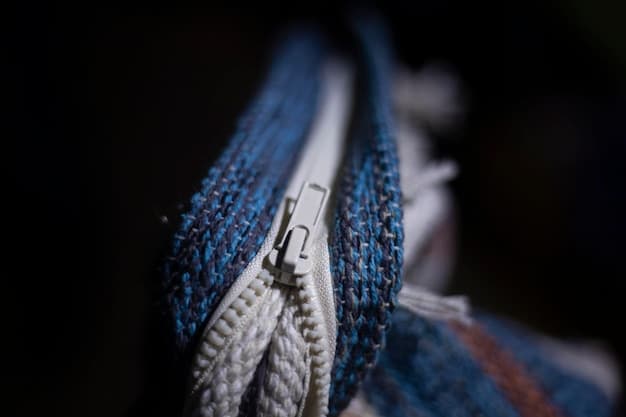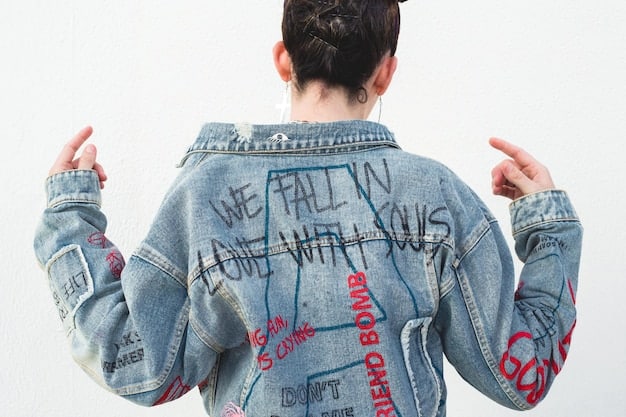Streetwear Fabrics 101: Choose Comfort & Durability

Streetwear Fabrics 101: Understanding Materials for Comfort and Durability explores the key fabric types—like cotton, polyester, and blends—that provide the best mix of comfort, style, and longevity for streetwear, helping consumers make informed choices.
Navigating the world of streetwear can be overwhelming, especially when it comes to understanding the fabrics that make up your favorite pieces. This guide to Streetwear Fabrics 101: Understanding Materials for Comfort and Durability will break down the essential materials, helping you make informed choices about comfort, style, and longevity.
Why Fabric Matters in Streetwear
Fabric is the foundation of any good streetwear garment. It dictates how the clothing feels, how it drapes, and how well it holds up to daily wear and tear. Understanding the properties of different fabrics can dramatically improve your streetwear game, ensuring your clothes are both stylish and functional.
Comfort and Feel
The comfort of a garment largely depends on its fabric. Natural fibers like cotton are breathable and soft against the skin, making them ideal for everyday wear. In contrast, synthetic fabrics like polyester can offer moisture-wicking properties, perfect for active lifestyles.
Durability and Longevity
Streetwear often needs to withstand a lot, from skateboarding sessions to crowded concerts. Durable fabrics like canvas, denim, and ripstop are built to last, resisting tears and abrasions. Investing in high-quality, durable fabrics means your favorite pieces will stay in rotation longer.

Choosing the right fabric is a balance between comfort and durability. Understanding the strengths and weaknesses of each material helps you make informed decisions.
Cotton: The Classic Choice
Cotton is a staple in the streetwear world, known for its comfort, breathability, and versatility. It’s used in everything from t-shirts and hoodies to pants and jackets, making it a go-to choice for many designers and consumers.
- Pros: Soft, breathable, absorbent, and relatively inexpensive.
- Cons: Can shrink, wrinkle easily, and may not be as durable as synthetic alternatives.
- Best For: Everyday wear, casual outfits, and garments that prioritize comfort.
Different types of cotton offer varying levels of quality and feel. Egyptian cotton and Pima cotton are known for their superior softness and durability, while organic cotton is a sustainable option that reduces environmental impact.
Care Tips for Cotton
To keep your cotton streetwear looking its best, wash it in cold water and avoid high heat in the dryer. Ironing on a medium setting can help reduce wrinkles, and storing your cotton garments properly can prevent stretching and fading.
Polyester: The Performance Powerhouse
Polyester is a synthetic fiber that excels in durability, water resistance, and wrinkle resistance. It’s often used in activewear and outerwear, providing protection from the elements while maintaining a sleek, modern look.
- Pros: Durable, water-resistant, wrinkle-resistant, and quick-drying.
- Cons: Less breathable than cotton, can feel slightly less comfortable against the skin.
- Best For: Outerwear, activewear, and garments that require durability and resistance to the elements.
Recycled polyester is an increasingly popular option, offering the same performance benefits as virgin polyester while reducing waste and environmental impact. Many brands are incorporating recycled polyester into their streetwear collections as part of their sustainability efforts.
Blending Polyester for Enhanced Performance
Polyester is often blended with other fibers like cotton or spandex to enhance its properties. A cotton-polyester blend can offer the comfort of cotton with the added durability and wrinkle resistance of polyester. Spandex adds stretch and flexibility, making the garment more comfortable and form-fitting.
Denim: The Timeless Staple
Denim is a durable cotton twill fabric that has been a staple in streetwear for decades. From jeans and jackets to hats and accessories, denim adds a rugged, classic edge to any outfit.

- Pros: Extremely durable, versatile, and develops unique wear patterns over time.
- Cons: Can be stiff, heavy, and may require a break-in period for optimal comfort.
- Best For: Jeans, jackets, and durable outerwear that can withstand frequent wear.
Raw denim, also known as dry denim, is denim that has not been washed or treated after dyeing. It’s prized for its ability to develop unique fade patterns and creases over time, making each garment truly one-of-a-kind. Washed denim, on the other hand, is pre-shrunk and softened for immediate comfort.
Caring for Denim
To maintain the unique look of your denim, wash it sparingly and inside out to prevent fading. Hang dry to avoid shrinkage and preserve the fabric’s integrity. For raw denim, consider spot cleaning or soaking in cold water to minimize color loss.
Technical Fabrics: The Modern Edge
Technical fabrics are engineered materials designed for specific performance characteristics. They often feature advanced properties like water resistance, breathability, and UV protection, making them ideal for streetwear that needs to perform in various conditions.
Common examples include:
- Ripstop Nylon: Lightweight, durable, and resistant to tearing, often used in outerwear and bags.
- Gore-Tex: Waterproof and breathable, providing excellent protection from rain and wind.
- Cordura: Highly abrasion-resistant, ideal for bags and accessories that need to withstand heavy use.
Many technical fabrics are treated with durable water repellent (DWR) finishes to enhance their water resistance. These finishes can wear off over time, so it’s important to reapply them periodically to maintain the fabric’s performance.
Sustainability in Technical Fabrics
Sustainable options for technical fabrics are becoming increasingly available. Recycled nylon and polyester are used to create high-performance materials with a lower environmental impact. Look for brands that prioritize eco-friendly materials and manufacturing processes.
Blends: Combining the Best of Both Worlds
Fabric blends combine different fibers to create materials with enhanced properties. This allows designers to tailor the fabric to specific needs, balancing comfort, durability, and performance.
Popular blends include:
- Cotton-Polyester: Combines the comfort of cotton with the durability and wrinkle resistance of polyester.
- Cotton-Spandex: Adds stretch and flexibility to cotton, making it more comfortable and form-fitting.
- Wool-Polyester: Enhances the durability and water resistance of wool, making it suitable for outerwear.
Understanding the composition of a fabric blend can help you predict its performance and care requirements. Look for blends that combine the strengths of different fibers while minimizing their weaknesses.
The Future of Fabric Blends
Innovations in fabric technology are leading to new and exciting blends that offer even greater performance and sustainability. Blends that incorporate recycled fibers, bio-based materials, and advanced finishes are paving the way for a more eco-friendly and high-performance future for streetwear.
Caring for Your Streetwear
Proper care is essential for keeping your streetwear looking its best and extending its lifespan. Always check the care label before washing or drying a garment, as different fabrics require different treatments.
General tips include:
- Wash in cold water: This helps prevent fading and shrinkage.
- Turn garments inside out: This protects the outer surface from abrasion.
- Avoid high heat in the dryer: This can damage fibers and cause shrinkage.
- Use a mild detergent: Harsh chemicals can break down fabrics over time.
For delicate items, consider hand washing or using a garment bag in the washing machine. Proper storage, such as folding or hanging garments correctly, can also help prevent wrinkles and stretching.
By understanding the properties of different fabrics and following these care tips, you can ensure that your streetwear remains stylish, comfortable, and durable for years to come.
| Key Point | Brief Description |
|---|---|
| 👕 Cotton Comfort | Soft, breathable, ideal for everyday wear but can shrink. |
| 💧 Polyester Durability | Water-resistant, wrinkle-resistant, perfect for activewear. |
| 👖 Denim Versatility | Durable, develops unique wear patterns, great for jeans and jackets. |
| 🧪 Technical Edge | Engineered materials for water resistance, breathability, and UV protection. |
Frequently Asked Questions
▼
Cotton and linen are your best bets for summer streetwear. They’re breathable and lightweight, helping you stay cool. Opt for lighter colors too, as they reflect sunlight better. Avoid heavier materials like denim if you want maximum comfort in the heat.
▼
Proper care is key. Always check the care label, wash in cold water, and avoid high heat in the dryer. Turn your clothes inside out to protect the colors and designs. Investing in durable fabrics like denim and technical materials also helps extend the lifespan of your garments.
▼
Technical fabrics are engineered for performance. They offer features like water resistance, breathability, and UV protection. This makes them great for streetwear that needs to handle different weather conditions or active use. Common examples include ripstop nylon and Gore-Tex.
▼
Organic cotton is grown without synthetic pesticides and fertilizers, making it a more sustainable option. It’s just as soft and breathable as regular cotton. Choosing organic cotton supports environmentally friendly farming practices and reduces your ecological footprint.
▼
Raw denim is denim that hasn’t been washed or treated after dyeing. It develops unique fade patterns over time. To care for it, wash it sparingly and inside out. Hang dry to avoid shrinkage. Some people even recommend spot cleaning or soaking in cold water to preserve the color.
Conclusion
Understanding the fabrics that make up your streetwear collection is crucial for maximizing comfort, durability, and style. By choosing the right materials and caring for them properly, you can ensure that your favorite pieces last for years to come, making a statement that’s both fashionable and functional.





